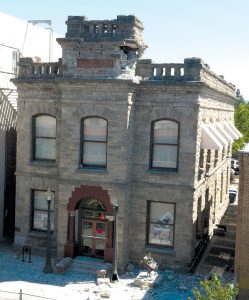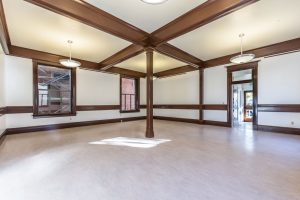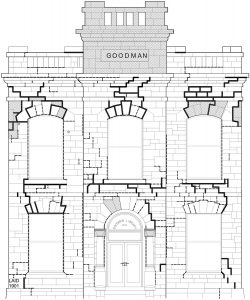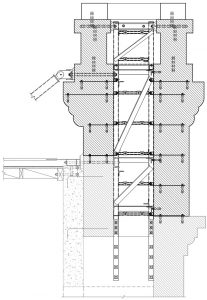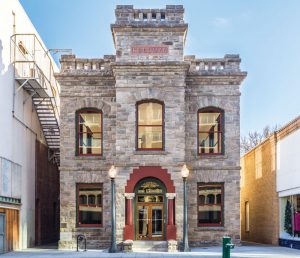Repair and Retrofit in the Aftermath of the 2014 Napa Earthquake
During the early morning hours of August 24, 2014, many of Downtown Napa’s historic buildings sustained moderate to heavy damage due to the powerful 6.0 magnitude earthquake that struck just over 5 miles away to the southwest. Among those was the iconic Goodman Library located in the heart of the city. All the building’s stone walls sustained damage in the form of cracks, but it was the partial collapse of its prominent tower that was remarkable (Figure 1). Shocked passers-by and news media assembled to view the stone rubble strewn about the sidewalk and to contemplate a “what if” scenario had the earthquake occurred during the downtown music festival just a half day prior. Barricades were established around the front of the building to protect bystanders from the dangers of large stones that could still come down. The partially-collapsed tower seemed to defy the laws of gravity, and even the smallest aftershock could quickly complete the demolition process, but, to everyone’s disbelief, most of the historic tower remained in place, damaged but not destroyed.
Built in 1901, the historic Goodman Library is a centerpiece of the downtown district in Napa, California. The structure is named for George Goodman, a local banker and philanthropist, who donated land and funds for the construction of the library. Upon his passing, the library was donated to the City of Napa with the caveat that it must be used as a free library; otherwise, ownership would revert to his heirs. Local architect Luther Turton, also the designer of several local churches, designed the Goodman Library in the Richardson Romanesque style and utilized native Napa field stone for construction. With an architectural style more typically associated with places of worship, the library presented a distinct façade amongst the predominantly Victorian-styled brick and wood structures of downtown. The library encompasses 5,400 square feet over two floor levels extending back within a deep, narrow lot. It is constructed with double wall unreinforced stone masonry: two wythes of mortared stone separated by a gap loosely filled with stone chippings and mortar. The stone exterior of the structure also features a castellated parapet and a stone tower over the main entry that displays a sandstone sign bearing the ‘Goodman’ name. The roof is framed with original repetitive timber trusses that are embedded into the stone walls for support. The interior spaces have maintained much of their original historical finishes, including wood trim, shelving, plaster walls, and pressed tin ceilings (Figure 2). The Goodman Library is the longest continuously operated library in California, previously housing the Napa County main library until 1971 and now home to the Napa County Historical Society, which has operated a non-circulating research library on site since 1976. The structure was placed on the National Register of Historic Places in January 1974.
Shortly after the earthquake, a state of emergency was declared in Napa thus freeing up federal funding for the County. This funding stream was critical in allowing rehabilitation to take place but also required strict stipulations with respect to the historic aspects of the building. To receive funding, all repairs and strengthening measures required full review by the State Historic Preservation Officer (SHPO) for conformance to the Department of Interior’s National Guidelines for Historic Preservation. Knowing these strict criteria had to be met, the City of Napa hired local historic preservation architect, Stephen Cuddy with Napa Design Partners, to assist with the documentation of damage and preparation of repair specifications.
The need to secure public funding and maintain historic status contributed to a prolonged schedule. It took more than a year before a temporary steel enclosure was finally secured around the damaged 8-foot-tall tower, intended to reduce the risk of harm to adjacent threatened buildings, as well as provide for a safe and complete assessment of damage.
The architectural and structural engineering teams performed an extensive survey of the damage. It was evident upon closer inspection that there was significantly more damage to the stone walls than initially suspected. Each stone and every crack was recorded by hand on building elevations for later conversion to electronic drawings (Figure 3).
Stones that were damaged or dislodged were noted in detail, as this process was also required to secure federal funding and to demonstrate compliance with historic standards.
Although the seismic damage was significant, it was also expected. Unreinforced masonry (URM) buildings are stiff and brittle, with limited ductility and energy dissipation capacity provided by the fracturing of mortar joints and rocking of wall piers. The overarching goal of seismic retrofit work in URM buildings is to address critical life-safety concerns to increase the likelihood that occupants can exit the building after an earthquake. Inherently, retrofit work does help protect the structure and limit the damage, but not avoid it altogether. The Goodman Library underwent two retrofits prior to the Napa Earthquake. In the 1970s, a tie-rod diaphragm system was added above the roof in an apparent attempt to anchor and support the stone parapets, mitigating one of the most significant hazards to public safety. In 2004, a more extensive retrofit and rehabilitation was performed by the City of Napa in advance of its upcoming URM retrofit ordinance. The retrofit design was based on the 1997 Uniform Code for Building Conservation (UCBC) with a design base shear of 0.10g (ASD) and out-of-plane wall anchorage demands of approximately 0.66g and 1.06g (ULT) at the 2nd floor and roof, respectively. Comparing these loads to the actual seismic event in 2014, the acceleration for the building was likely between 0.90g and 1.20g (based on a ground motion monitoring device less than ¼ mile away) (FEMA P-1024). The ASCE 7-10 design base earthquake acceleration is 1.35g for the building. Using a response modification factor of R = 1.5 for an ordinary plain masonry shear wall structure, the resulting design acceleration is 0.90g, though the California Historic Building Code (CHBC) permits further reduction.
The 2004 retrofit performed quite well during the 2014 seismic event, despite the overall ragged appearance of the building immediately following the earthquake: the transverse concrete shear walls exhibited little to no signs of distress, as did the roof and floor diaphragms and wall anchors. The historic stone walls, which acted as the building’s shear walls in the longitudinal direction and at the rear of the building in the transverse direction, performed as expected, dissipating energy by cracking along joint lines.
The focus of the post-earthquake damage investigation was the tower, where the partial collapse allowed large stones to fall 30 feet to the sidewalk below. Exploration within the tower cavity revealed minimal existing lightweight steel frames for support. These frames, likely part of the 1970s retrofit work, lacked adequate stiffness to prevent substantial displacements of the stone. Additionally, the rock anchors from the steel frame to the stone masonry were an expansion style anchor embedded only into the inner wythe, leaving the outer wythe unsupported. Not only was a new, stronger frame needed within the tower, but external bracing from the backside of the tower to the roof framing was also recommended to reduce displacement of the tower and alleviate the deficiency. Before embarking on the design, however, SHPO required a visual assessment of the impact of the proposed external steel braces from street-view. Approval was granted after a simulation using BIM modeling was developed to demonstrate the bracing had little visual impact on the street-level view of the historic façade.
The new steel space frame, composed of angles and channels, was designed to fit within the core of the vulnerable tower, acting as a backbone (Figure 4). Provisions from ASCE7-10 for a braced non-structural cantilever element were used as the basis of design, the same as would be used for a braced parapet or chimney. It is worth mentioning that the CHBC requires parapets and similar exterior decorations to comply with regular code requirements for anchorage and strength, recognizing the public safety hazard these elements present. Though inserting a stiff space frame could result in higher accelerations at the tower, it was the preferred solution to limit local displacement which could lead to wide, cracked mortar joints and then dislodged falling stones. Detailing of the frame was explicitly designed for flexibility of installation by skilled masons from Rainbow Waterproofing & Restoration Inc. As individual layers of stones were reinstalled in their original positions around the tower, heavy steel straps were laid within the horizontal mortar beds, interconnecting the interior and exterior wythes, and attached to the steel frame with self-drilling screws (or field welds) at specified locations. The closely-spaced straps were attached to the stones with two vertical adhesive anchors and hidden within the bed joints of the tower walls. This versatile connection detailing allowed for flexibility during the installation by the masons as they reconstructed the tower over several months. During reinstallation, some stones were deemed too damaged for reuse. Fortunately, a nearby historic URM building recently completed a remodel and had leftover matching stones available, allowing the tower to be rebuilt entirely from local, historically accurate materials.
The dual-wythe construction of the exterior walls of the library posed added challenges. During the 3-month assessment process, the exterior damage was apparent and abundant, but damage to the interior wythe remained hidden beneath wood-framed furring walls with historic wood lath, wood trim, and plaster finishes. Rather than specify that all interior historic wall finishes be removed to allow inspections to occur, the design team assumed that the exterior wythe damage was mirrored at the interior. Localized areas of plaster were selectively demolished to check the stability of the interior stone wall wythe and review the extent of structural damage. Fortunately, the assumption was verified, and interior furring walls were only specified to be removed at isolated areas reflecting exterior damage, saving time and cost, as well as maintaining the historic finishes as best possible.
Segments of the stone walls that were displaced and significantly cracked were to be documented, then disassembled and rebuilt to historic standards. Other less damaged areas were repointed and grout-injected with historically accurate lime-based grout to regain the structural integrity of the wall. Contrary to popular belief, replacement mortar and grout should contain low amounts of cement compared to lime so that it is permeable and softer, allowing the masonry to “breathe” and to prevent fracturing of the stone units themselves during an earthquake. The replacement mortar must also match the historic mortar in color, texture, and tooling. As an added benefit, the grout injection of the cracks filled voids present between the individual wythes of the stone wall, bonding them together.
Additional damage was observed during an investigation of the attic area. Several existing timber roof trusses, whose chord members were separated at the heels, were repaired using plywood gusset plates. As an added measure of precaution, the oversized pockets in the stone walls receiving and supporting the trusses were fully grouted and pointed. Anchoring the new tower braces to the roof required several of the original trusses to be reinforced with steel side plates at chord-to-web connections to provide additional capacity, and chords were braced for increased compression loads. The steel beams added to distribute forces from the braces to the trusses were detailed as relatively short and light pieces due to the limited access to the attic area; opening up the roof was not a viable option due to cost and risk of exposure to weather.
As a building occupant, the Napa County Historical Society was integral in the restoration process and maintaining the historical accuracy of the library. All materials were reused or replaced in kind where possible. Wooden fixtures and trim were cataloged for repair and reinstallation, damaged terra cotta columns at the entry were recreated, dislodged tin ceilings were reinstalled, and the damaged sandstone sign at the top of the tower was repaired and restored. Work on the Goodman Library was completed in December 2017, three years after the earthquake. With the addition of a new support structure at the tower, restored historical stone construction, strengthened critical connections, and rejuvenated finishes inside and out, the Goodman Library will continue to be an integral part of Napa’s history for years to come. Of note, the library restoration project has been recognized on both local and national levels, having won the American Public Works Association (APWA) National Award for Historical Restoration & Preservation as well as preservation awards from the Structural Engineers Association of Northern California (SEAONC) and California Preservation Foundation (CPF).■

